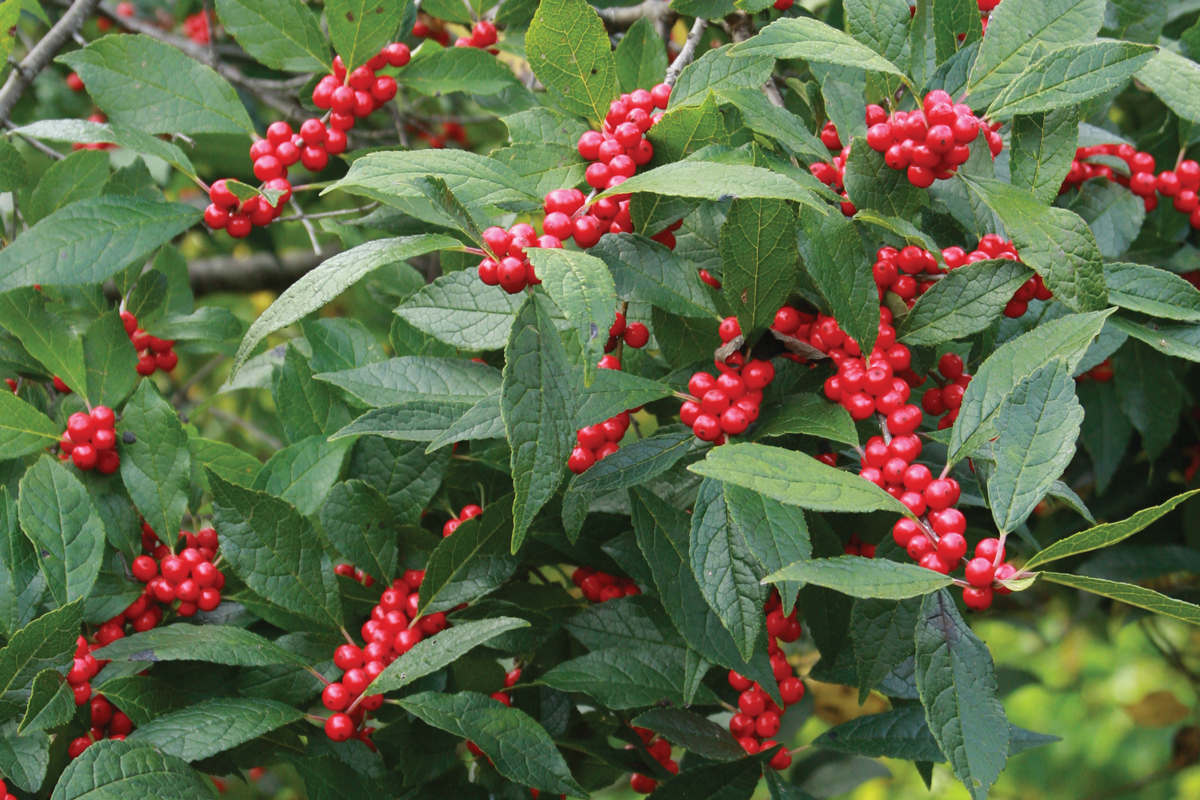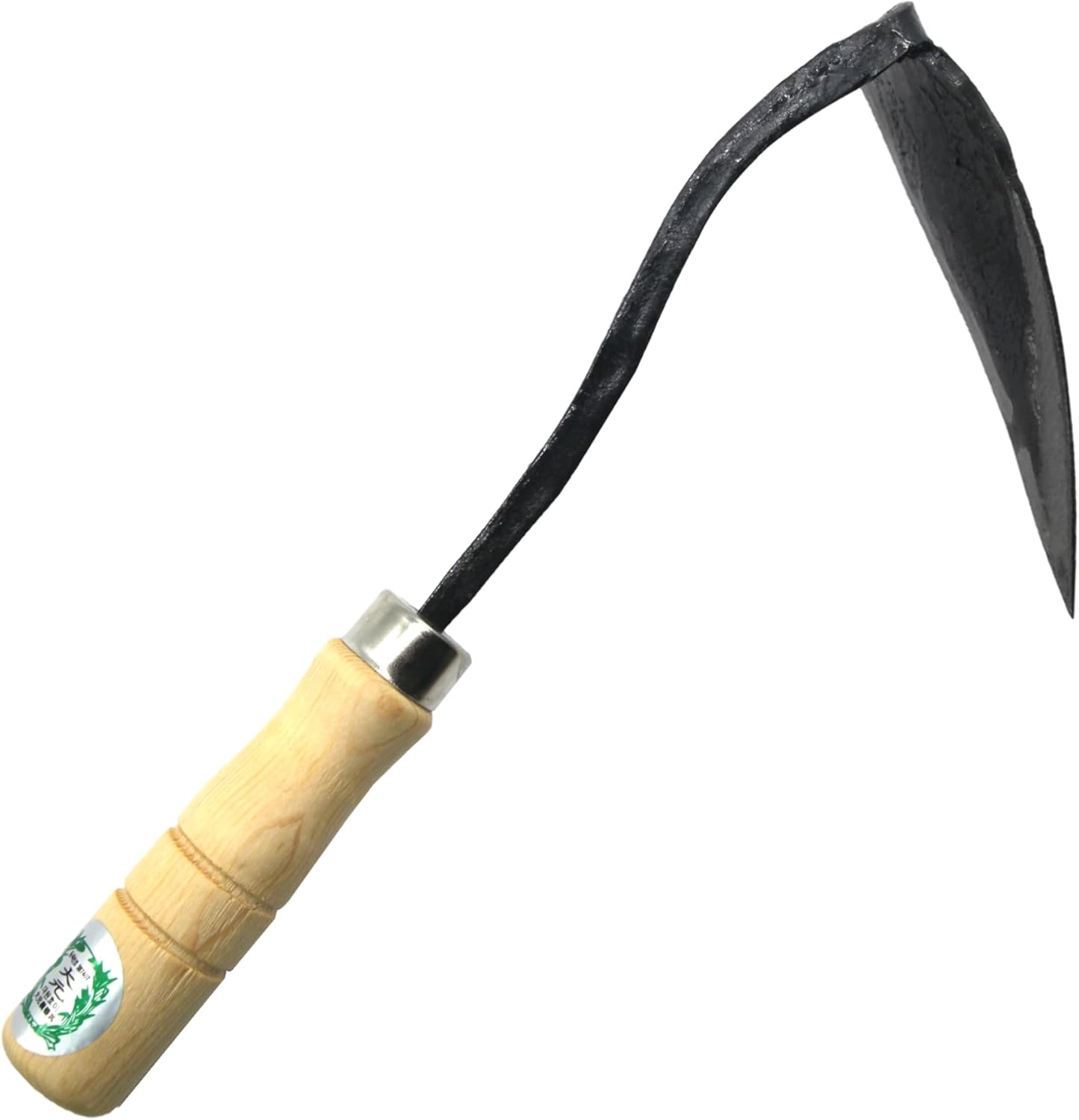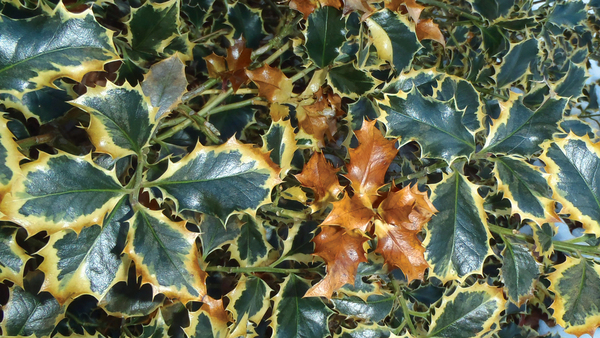
Why is it that some people think the thrill of the growing season is over after the first frost? For those of us who grow Ilex cultivars (Zones 4–9), the onset of cooler weather marks the time when their colorful berries, handsome evergreen foliage, and appealing forms truly shine. This genus offers an amazing array of gardenworthy trees and shrubs, and in sizes and shapes to fit nearly every situation.
Most hollies are dioecious, meaning that male and female flowers are borne on separate plants. Clearly marked male pollenizer cultivars often are available at the nursery. If males and females are not individually marked, shopping in spring when female hollies are flowering will ensure that you get the right mix of male and female plants.
Learn how to Avoid Winter Damage to Your Holly
Pollination is usually accomplished by flying insects that are attracted to the pleasant scent of the spring flowers. Only the female hollies produce fruit, which are technically called drupes. These may be red, orange, yellow, or black depending on the species. Whether you are looking for a plant that is evergreen or deciduous, large or small, for full sun or for partial shade, there is sure to be a holly that is just right for your garden.
Beautiful fruit brightens the winter landscape
‘Winter Red’ and ‘Winter Gold’ winterberry are delightfully decorative

Name: I. verticillata ‘Winter Red’ and ‘Winter Gold’
Zones: 4–9
Size: 8 feet tall and wide
Conditions: Full sun to partial shade; average to wet soil
Native range: Eastern North America
Pollenizer: ‘Southern Gentleman’ winterberry (I. verticillata ‘Southern Gentleman’)

Leading the way in outstanding color is ‘Winter Red’ winterberry, a deciduous, suckering shrub with red drupes that persist on the branches long after its leaves have fallen. ’Winter Gold’, discovered as a sport of ‘Winter Red’, has peach- or salmon-colored fruit. During the growing season, both of these cultivars have medium green, elliptical-shaped leaves that are lighter on the underside. Although the straight species is typically found in moist areas such as swamps and bogs, winterberry also grows well in average garden soil. Branches can be harvested to use for decorating; they can also be left intact, to the delight of winter wildlife. To ensure berry production, be sure to plant an appropriate male pollenizer nearby.
Longstalk holly puts a new spin on the classic look

Name: Ilex pedunculosa
Zones: 5–8
Size: 20 to 30 feet tall and 15 to 20 feet wide
Conditions: Full sun to partial shade; moist to average, well-drained soil
Native range: Japan, Korea, southern China
Pollenizer: Male longstalk holly (I. pedunculosa)
In second place for interesting fruit is longstalk holly, a species that grows in thickets in its native regions of Asia. It has dangling drupes that resemble shoulder-duster earrings and foliage that is reminiscent of mountain laurel (Kalmia latifolia, Zones 5–9), so some observers may be surprised when they find out that it is a holly. Mildly fragrant flowers are borne on long stalks, or peduncles, followed by fruit that sways in the slightest breeze. Longstalk holly matures into a conical tree with dense, evergreen foliage. Despite a lack of spines on the leaves, deer seem generally uninterested in this species.
Choose Red Beauty® holly for early fruit color

Name: I. ‘Rutzan’
Zones: 6–9
Size: 8 to 10 feet tall and 4 to 6 feet wide
Conditions: Full sun; moderately moist, well-drained soil
Native range: Hybrid
Pollenizer: Blue Prince® blue holly (I. × meservae ‘Conablu’)
Red Beauty® holly is a good choice for anyone seeking a classic “holly look” in a more confined space. It has small, spiny leaves, lovely dark color, and a nice conical shape. Bright red drupes develop their color in late summer, which is much earlier than most other hollies. These contrast nicely with the dark green foliage and add to the plant’s visual appeal in winter. Try using Red Beauty® as a backdrop for white-margined ‘Patriot’ hosta (Hosta ‘Patriot’, Zones 3–8) or bold-flowering perennials.
Standout foliage is another strong selling point
‘Dan Fenton’ American holly is tall, dark, and handsome
 |
 |
Name: I. opaca ‘Dan Fenton’
Zones: 5–9
Size: 20 to 30 feet tall and 20 feet wide
Conditions: Full sun to partial shade; moist, acidic, well-drained soil
Native range: Eastern and south central United States
Pollenizer: Any male American holly, such as ‘Jersey Knight’ (I. opaca ‘Jersey Knight’)
With some of the darkest and glossiest foliage of any North American native holly, ‘Dan Fenton’ American holly cannot be ignored. Despite this cultivar’s masculine-sounding name, it is a female holly and bears dark red fruit. Bred by Prof. Elwin Orton of Rutgers University, it was named in honor of Daniel Fenton, one of the founders of the Holly Society of America. It grows a foot or more each year on its way to becoming a stately conical tree, and it has little to no need for pruning or staking. It makes a fine stand-alone specimen but is also an excellent choice for a tall privacy hedge. Its branches reliably bear heavy crops of bright red fruit that is attractive to wildlife and suitable for holiday decorating.
Liberty™ holly has the glossiest leaves of all
 |
 |
Name: I. ‘Conty’
Zones: 7–9
Size: 8 to 10 feet tall and 6 to 10 feet wide
Conditions: Full sun; average to moist, well-drained soil
Native range: Hybrid
Pollenizer: Blue Prince® blue holly
Another variety with incredibly beautiful foliage is Liberty™ holly. This hybrid features large, glossy leaves with small, regularly spaced serrations along the leaf margins that are stiff to the touch but not sharp or spiny. It grows rather slowly into a small, perfectly shaped, broadly conical tree that never needs pruning, making it suitable for smaller gardens. Liberty™ was an open-pollinated seedling of the hybrid cultivar ‘Mary Nell’ (I. ‘Mary Nell’, Zones 7–9) and shares the highly glossy foliage of its maternal parent. As a bonus, it bears heavy clusters of bright red fruit.
Golden highlights are the signature look of ‘Whoa Nellie’ holly
 |
 |
Name: I. ‘Whoa Nellie’
Zones: 6–9
Size: 20 to 25 feet tall and 15 to 20 feet wide
Conditions: Full sun; moist, well-drained soil
Native range: Hybrid
Pollenizer: Male Japanese holly (I. crenata); male blue holly (I. × meservae); male English holly (I. aquifolium*)
If subtlety has never been your strong point, you’ll love ’Whoa Nellie’ holly. This gold-leaved form of the more familiar ‘Nellie R. Stevens’ (I. ‘Nellie R. Stevens’, Zones 6–9) makes a bold statement in any sunny landscape. It was discovered by Prof. Michael Dirr at the University of Georgia and was later named and introduced by nursery owner Tony Avent. New growth emerges a screaming bright yellow and then turns into a burnished gold later in the season in a contrast to its older, all-green foliage. Bright orange-red fruit adds to its winter appeal. Vigorously growing 1 to 2 feet per year, it will develop into a medium-size conical tree. For a fun color echo, plant it with Sombrero® Lemon Yellow coneflower (Echinacea ‘Balsomemy’, Zones 5–9).
‘Foster No. 2’ Foster holly sports unusually narrow foliage

Name: I. cassine × opaca ‘Foster No. 2’
Zones: 6–9
Size: 15 to 25 feet tall and 10 to 15 feet wide
Conditions: Full sun to partial shade; moist, acidic, well-drained soil
Native range: Hybrid of North American native species
Pollenizer: Self-fruiting
‘Foster No. 2’ Foster holly is a small tree that is the result of an interspecific cross between two native hollies—American holly (I. opaca, Zones 5–9) and Dahoon holly (I. cassine, Zones 7–11). It grows into a conical, upright tree with comparatively narrow evergreen leaves. Among the few hollies that are self-fertile, it produces heavy crops of fruit without a pollenizer nearby. A bit smaller and narrower than its American holly parent, ‘Foster No. 2’ thrives in the hot, humid summers of the southeastern United States.
Compact varieties pack plenty of charm
‘Maryland Dwarf’ American holly makes an excellent ground cover

Name: I. opaca ‘Maryland Dwarf’
Zones: 5–9
Size: 3 feet tall and 10 feet wide
Conditions: Full sun to partial shade; moist, acidic, well-drained soil
Native range: Eastern and south central United States
Pollenizer: Any male American holly, such as ‘Jersey Knight’
Susan Hunter, president of the Holly Society of America, enjoys ‘Maryland Dwarf’ American holly for its versatile nature and low-growing, spreading habit. She recommends using it as a single-specimen focal point in a rock garden paired with seasonal native perennials such as foamflower (Tiarella cordifolia and cvs., Zones 3–8) or golden Alexander (Zizia aurea, Zones 3–9). Its size and habit also make it suitable for foundation plantings and as a ground cover on slopes.
Add irresistible texture with compact ‘Soft Touch’ Japanese holly

Name: I. crenata ‘Soft Touch’
Zones: 6–9
Size: 2 to 3 feet tall and wide
Conditions: Full sun; average to moist, well-drained soil
Native range: Japan, Korea
Pollenizer: Individually sexed plants are generally not labeled
If you’re looking for a holly that’s soft and cuddly, ‘Soft Touch’ Japanese holly has tiny, narrow, spineless leaves that retain their soft texture throughout the growing season. With a compact, spreading habit, it is ideal for foundation plantings and island beds. Site this gentle plant close to walkways, where children and young-at-heart gardeners can pet it. For a tactile sensory garden, grow it alongside lambs’ ears (Stachys byzantina, Zones 4–9), spiky-centered coneflowers (Echinacea spp. and cvs., Zones 3–9), and feathery dill (Anethum graveolens, annual).
Cold-hardy ‘Shamrock’ inkberry has a dense, rounded habit

Name: I. glabra ‘Shamrock’
Zones: 4–9
Size: 3 to 5 feet tall and wide
Conditions: Full sun to partial shade; average to wet, acidic soil
Native range: Eastern and south central United States
Pollenizer: Individually sexed plants are generally not labeled
Soft and subtle is a great way to describe ‘Shamrock’ inkberry, an outstanding selection from a well-loved native species that is our hardiest broadleaf evergreen and is found from the Maritime Provinces of Canada all the way to the Gulf Coast. ‘Shamrock’ grows slowly into a multistemmed, rounded shrub, and its dense evergreen foliage makes it a good choice for foundation plantings and low hedges. Like all inkberries, it tolerates wet soil. Small white flowers in late spring are highly attractive to pollinating insects, and honeybees make a fine honey from its nectar. Though its black fruits aren’t showy, they are much appreciated by wildlife.
*Invasive alert: English holly (Ilex aquifolium)
This plant is considered invasive in AK, CA, and OR.
Please visit invasiveplantatlas.org for more information.
Jim Resch, PhD, chair of the Research and Development Committee of the Holly Society of America, grows and evaluates new holly cultivars. Mary Tipping is the curator and plant recorder at the Scott Arboretum of Swarthmore College in Swarthmore, Pennsylvania.
Fine Gardening Recommended Products

Ho-Mi Digger - Korean Triangle Blade
Fine Gardening receives a commission for items purchased through links on this site, including Amazon Associates and other affiliate advertising programs.

ARS Telescoping Long Reach Pruner
Fine Gardening receives a commission for items purchased through links on this site, including Amazon Associates and other affiliate advertising programs.

The Regenerative Landscaper: Design and Build Landscapes That Repair the Environment
Fine Gardening receives a commission for items purchased through links on this site, including Amazon Associates and other affiliate advertising programs.


















Comments
Log in or create an account to post a comment.
Sign up Log in